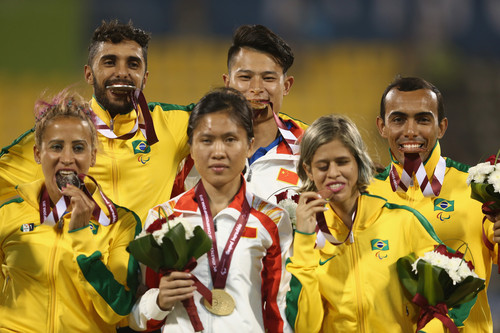 An IPC Award Ceremony, from IPC
An IPC Award Ceremony, from IPC
Stuart Weir wrote this piece on the diversity and the complexity of the IPC Athletics World Championships. A piece worthy of your consideration, and a piece that has encouraged me to put an IPC champs on my bucket list.
RelatedPosts
The most positive thing about disability athletics is its diversity and the most negative is its complexity.
There are 45 different medal events in the IAAF World Championships – 22 for women, 23 for men (the 50K is for men only). In the IPC World Championships there are 214 medal events. The club throw is the only event unique to the IPC athletes.
The motto of Doha 2015 is “Beyond incredible”. The whole event illustrates the determination of the athletes to compete. OK – so I can’t see, then I will run with a guide. I have lost a leg so I will run with a blade. I can’t walk so I will race in a wheelchair. I have cerebral palsy or have a deformed arm, so I can’t run as fast as Usain Bolt (well none of us can!) but I will train hard and run as fast as I can.
The complexity is well illustrated by the 100 metres. In The IAAF World Championships in Beijing, there is a men’s 100 metres and a women’s 100 metres and as everyone knows Usain Bolt won the men’s and Shelly-Ann Fraser-Pryce the women’s. But do you know who won the last IPC World Championship 100 metres? Well there are twenty-eight 100 metre races in the IPC World Championships so 14 men and 14 women will leave Doha as world 100 metres champion in their class. But none of them can claim to be the 100 metres champion.
Another complexity is mixed classifications. The 2012 amputee long-jump competition ended with Stef Reid jumping 5.28 and Kelly Cartwright 4.38 so of course Cartwright was the winner. Really? Cartwright was an F42 in this mixed classification competition and her 4.38 converted to 1030 points while F42, Stef Reid’s 5.28 gave her 1023 points, leaving Cartwright with the gold medal. Of course you can argue all day about whether the formula for converting distance to points correctly assesses the amount of advantage a below the knee amputee has over an above the knee. Nonetheless a long-jump competition in which the winner is not the person who jumps furthest is not the winner.
For me the diversity and the sheer level of achievement enables me to accept the complexity. From athletes with visual impairment to amputees and from cerebral palsy to wheelchair there is a vast spectrum of talented athletes. Remember the quote from Tatyana McFadden: “I don’t see myself as ‘disabled’; I see myself as very able”. Marcus Rehm in long-jumping 8.40 this week pleaded to be allowed to compete in the Olympics – not for personal glory but to “show what we paralympic athletes are capable of”.
Anyone privileged to be in the Suhaim Bin Hamad Stadium in Doha this week, will be left in no doubt that what paralympic athletes are capable of is beyond incredible.
P.S. A problem unique to Para-athletics surfaced in the women’s F11 200 metres final. Favourite, Terezinha Guilhermina could only take silver – hampered by injury. However, it was not her injury but an injury to her guide, Guilhermine Soares de Santana, which slowed him down – and her in turn.
Author

Since 2015, Stuart Weir has written for RunBlogRun. He attends about 20 events a year including all most global championships and Diamond Leagues. He enjoys finding the quirky and obscure story.
View all posts




















